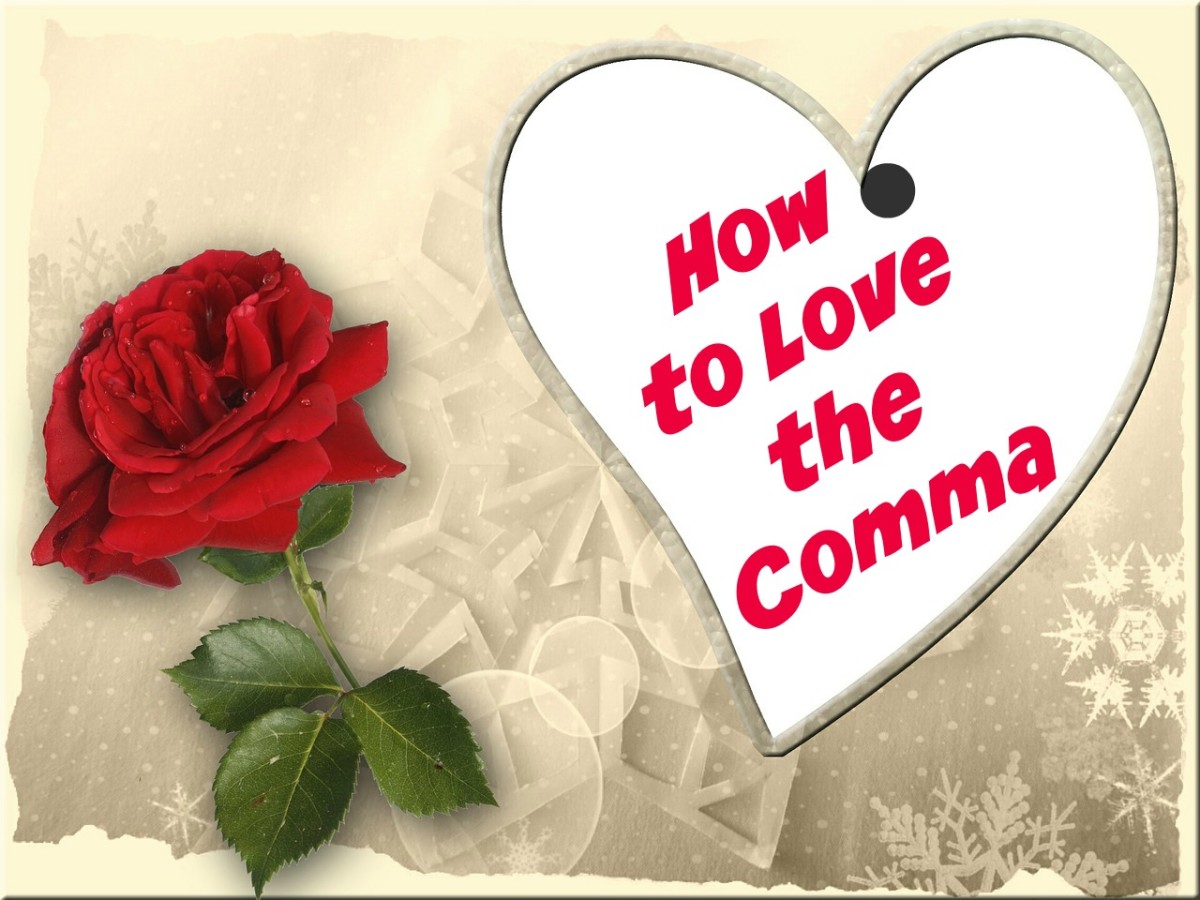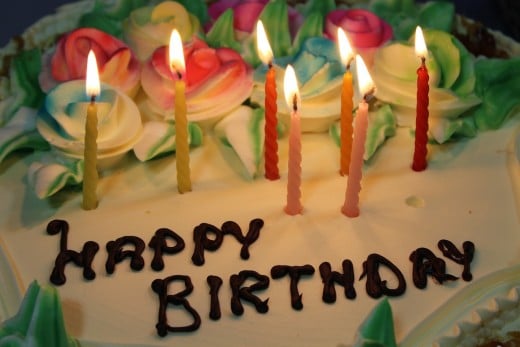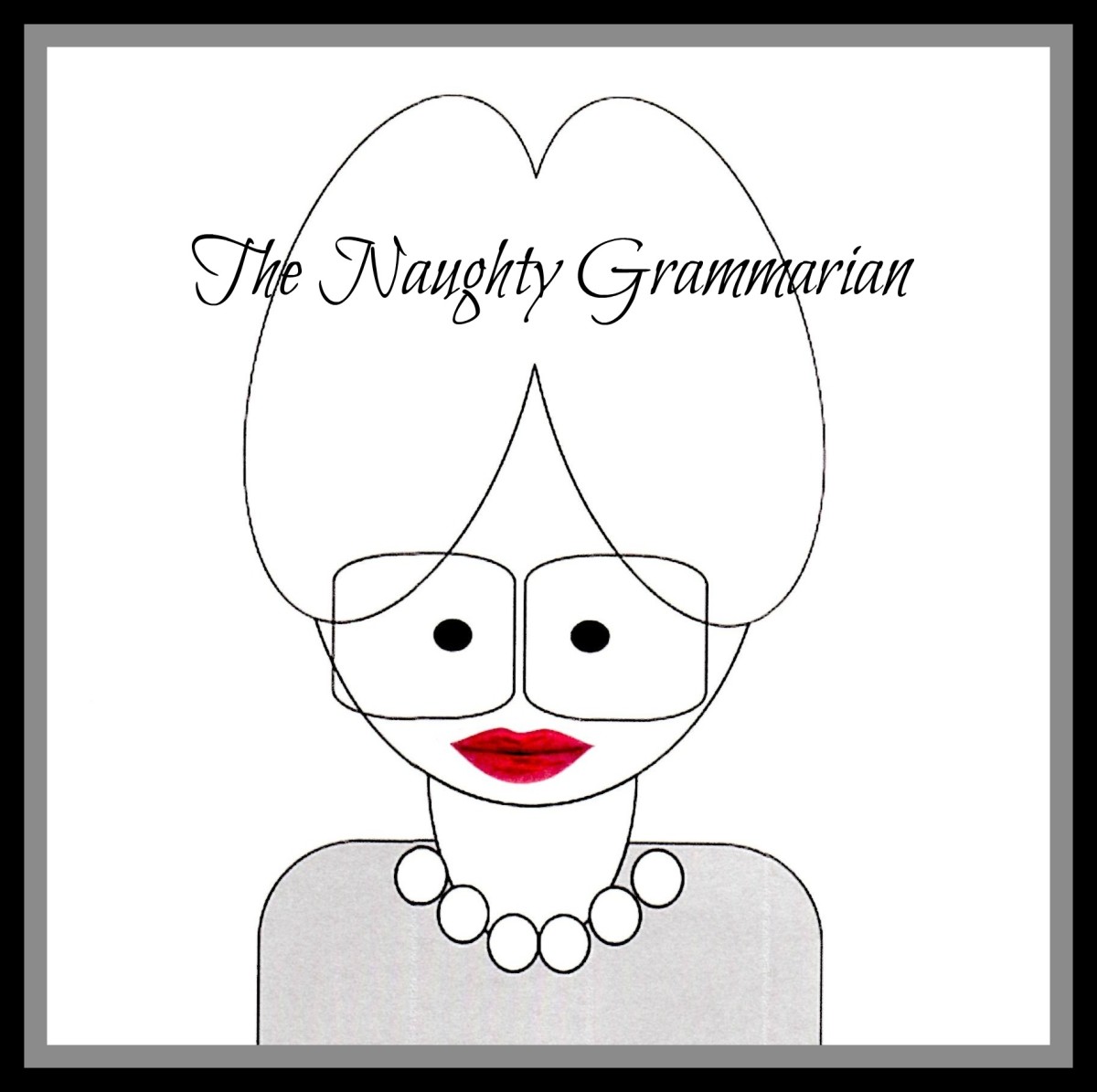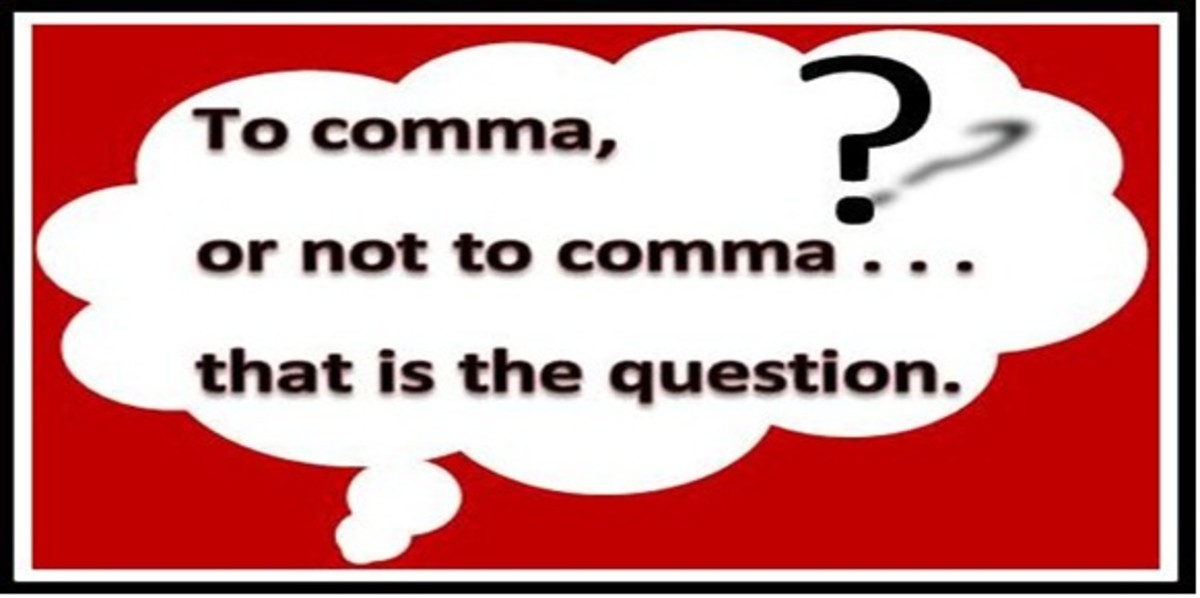How to Use Commas: The Naughty Grammarian Explains
Do You Love the Comma?
The comma is always there, so much so that it is taken for granted. It is time for everyone to learn how to love the comma. .

The apostrophe is sexy. It floats above the fray looking like the curl on the forehead of the little girl who was horrid. She’s a siren who possesses you.
The comma is more like the sweet girl next door. She’s down-to-earth. She suggests that you pause for a moment.
The Naughty Grammarian: How to use Apostrophes explained the wily ways of the apostrophe. Now the Naughty Grammarian will explain the ways of the comma. Treat the comma well and she will be your help-mate throughout life. Misuse her and she turns vexatious.
Enough of the tortured analogies! Miss Grammers must now get down to the task of instructing you in the use of the comma.
Please vote in this poll. Miss Grammers is curious to know.
Are you confident that you know how to use the comma correctly?
Why is the Comma Important?
A comma can change the entire meaning of a sentence.
In the book Eats, Shoots & Leaves, the author, Lynne Truss, gives an example with her title.
“The panda eats shoots and leaves.” Without the commas, this sentence describes the dietary habits of a bear native to South Central China.
“The Panda eats, shoots, and leaves.” With commas added, the sentence describes a panda with a criminal bent. (The sentence perhaps makes more sense if you think of “The Panda” as being like “The Penguin” from the Batman comics and movies.)
Here is another example. How would you punctuate this sentence?
A woman without her man is nothing.
Depending on the placement of the punctuation, especially the commas, the sentence means two directly opposite things.
A woman, without her man, is nothing.
A woman: Without her, man is nothing.
By the way, the word comma comes from Greek: it means "a little piece cut off.”

How are Commas Used in Lists?
When there are three or more words in a list, a comma separates each of the words.
Melanie was young, bold, and beautiful.
In the example above, Miss Grammers has used the “Oxford comma.” This refers to the practice of using a comma after each item in the list.
However, you will sometimes see the sentence punctuated like this.
Melanie was young, bold and beautiful.
I think the second example is not quite clear in its meaning. Is “bold and beautiful” meant to be read as a phrase or as two separate attributes?
Try this sentence with and without the Oxford comma.
Melanie‘s favorite breakfast foods are pancakes, sausage, bacon, and eggs.
Melanie‘s favorite breakfast foods are pancakes, sausage, bacon and eggs
The Oxford comma tells us that the bacon is a side dish and is not part of one dish known as “bacon and eggs.”
As with other grammatical issues when there are two correct choices, you can chose one or the other just as long as you are consistent. Miss Grammers prefers the Oxford comma because it does not leave room for confusion.
The list can be a list of nouns, verbs, adjectives, or adverbs.
Melanie, Doug, and Linda went on a picnic.
They ran, skipped, and jumped.
Melanie spoke loudly, quickly, and forcefully.
Sometimes when there are two adjectives together and they are close synonyms, a comma can be used instead of the word “and”.
Melanie’s strong, fierce love would prove to be her undoing.
Do not use a comma in lists where the word “and” or the word “or” would not make sense.
Melanie loved expensive French champagne.
In the above sentence, we are not listing the attributes of the champagne as “expensive” and “French.” We are saying French-champagne is expensive, and thus there is no comma between “expensive” and “French.”
Commas enclose the abbreviations used with lists like, e.g. (“for example” from the Latin exampli gratia), i.e (“that is” or “in other words” from the Latin id est), and etc.(“and other similar things” from the Latin et cetera. (By the way, there is no need to italicize these abbreviations in normal use, but be sure to use the periods.)
Melanie thought that her ideal man should have the character traits that she admired, e.g., trustworthiness, honesty, faithfulness.
Melanie wanted a man of good character, i.e., a man she could trust, a man who was honest, a man who was faithful.
Melanie thought trustworthiness, honesty, faithfulness, etc., were important character traits.

How are Commas Used to Join Sentences?
Use a comma to separate two independent clauses joined by the word “and” or other conjunctions such as “but,” "or,’ or “yet.” (An independent clause has both a subject and a verb. If the comma was replaced with a period and the conjunction omitted, the sentences could stand on their own.)
Melanie wanted to continue on her quest to win Doug’s love, but she recognized that it might be a lost cause.
Melanie knew it was a lost cause, yet she continued on her quest to win Doug’s love.
The exception is when the two independent clauses are very short.
Melanie could stay or she could leave.
Avoid run on sentences. This is a sentence that should be two separate sentences or one sentence with a conjunction joining them. Sometimes you can avoid a run on sentence, by using a semicolon. A semi-colon joins two sentences that are part of one thought. For reasons of style, the conjunction that could have joined them is omitted.
Melanie knew she should leave; her heart would not let her.
However, if the two parts of the sentence are not closely related, you must use a period or a joining conjunction with a comma.
Melanie knew she should leave. Her heart pounded in her chest.
Melanie’s heart pounded in her chest, and she knew she should leave.
Note that the two examples above seem to be saying the same thing, but there is a subtle difference. In the first knowing that she should leave makes her heart pound, and in the second, the pounding in her chest tells her she should leave. This has nothing to do with punctuation; it’s just an interesting comment on style.
Wrong: Her heart pounded in her chest, she knew she should leave.
If there is no subject in the second clause following the conjunction, do not use a comma.
Melanie loved Doug and hated him too. [There is no second subject, so no comma is needed.]

How are Commas Used to Separate Words that Introduce or interrupt a Sentence?
Sometimes a word at the beginning of a sentence is not actually part of the sentence, but is added or emphasis. Separate it from the rest of the sentence with a comma.
No, I can’t believe Doug does not love me.
But, this contradicts everything I know about Doug.
If a phrase interrupts a sentence it must have a comma before and after.
I am, by the way, a serious person.
I am, and you know this to be true, a serious person.
This also applies to a name or proper noun.
Doug, please don’t say these things.
What can I say, my lord and master, to change your mind?
Hand me a towel, sweetie.
How are Commas Used With Names?
The use of commas with names is very confusing. Miss Grammers advises you to pay close attention.
Use a comma with a name only if you are referring to unique person or thing, a "one-and-only.”
A comma is used when the name is not necessary because the person or thing you are speaking of is the only one. The name is non-essential. It is like the commas are parentheses. The part of the sentence in parentheses (or within the commas) can be removed and the meaning is still clear.
Doug’s best friend, Brad, will be at the party. [Doug has only one best friend and his name is Brad--the name is not essential so it is in commas.]
Melanie’s sister, Jill, will also attend. [Melanie has only one sister and her name is Jill.]
A scene from Shakespeare’s best play, Romeo and Juliet, will be performed. [Shakespeare has many good plays, but, by definition, he can have only one best play.]
Do NOT use a comma with a name if there is more than one of the thing being named.
If there is more than one friend or sister or play (or whatever), commas are not needed. This is because the name becomes an identifier for the noun that precedes it. We don’t know which of the many things described by that noun is being referred to so the noun becomes similar to an adjective that describes the name, and we don’t use commas after a single adjective.
If you would need to ask which one, commas are not needed.
Doug’s close friend Brad will be at the party. [Doug has several close friends so we must specify which one we are talking about. Brad is described by the word friend.]
Melanie’s sister Jill will be at the party. [Melanie has more than one sister, and we are identifying which sister will be at the party.]
A scene from Shakespeare’s play Romeo and Juliet will be performed [Shakespeare wrote many plays so it is essential to identify which one is being performed.]
However, when the identifier comes after the name, we use the commas.
Brad, Doug’s best friend, will be at the party.
Jill, my sister, will be at the party.
A scene from Romeo and Juliet, a play written by Shakespeare, will be performed.
With grammar, there is always an exception.
There is an exception to the only-thing-in-the-world rule. If the words “a,” “an” or “some,” or a number precede the description of the person named, use a comma. This is because these words make the noun unique by referring to a specific person(s) or thing(s).
A good friend, Brad, will be at the party.
Some good friends, Brad and Bill, will be at the party.
Two friends, Brad and Bill, will be at the party.

How are Commas Used with a Dependent Clause?
A dependent clause is a clause that cannot stand alone as a sentence, but it precedes and is closely tied to the sentence it is a part of. If the clause is after the main part of the sentence, no comma is needed.
After we go to the movie, we should go straight home.
We should go straight home after we go to the movie.
Since you refuse to listen, I won’t bother to explain.
I won’t bother to explain, since you refuse to listen.
How are Commas Used with Quotations?
In American English, the final comma goes inside the quotations marks.
Melanie said, “I will never forgive you.”
“I will never forgive you,” Melanie said.
Melanie said, “I will never forgive you,” as she began to cry.
If the quote is a single word and it follows the attribution, a comma need not be used. However, if it precedes the attribution, it requires a comma. (The attribution is the word said, cried, reported, etc.)
She said “No.”
“No,” she said.
How are Commas Used to Separate Contrasting Parts of a Sentence?
When the second part of the sentence is meant to contrast with the first part of the sentence, a comma is used to separate them.
He loves me, not you.
It’s about love, not need.
Use a coma to separate a statement from a question when they occur in the same sentence.
It’s my party, so can I cry if I want to?
How are Commas Used with Dates?
A date sometimes requires a comma and sometimes does not.
A date that gives the month, date, and year requires a comma. The comma is needed before the year when a date precedes the year, but is not needed if only the month precedes it. A day of the week follows the same rules.
Melanie’s birthday is January 9, 1994.
Melanie’s was born in January 1994.
Melanie was born on Monday, January 9.
The comma is also needed after the year if the sentence does not end with the year.
January 9, 1994, is the date of Melanie’s birth.
Monday, January 9, 1994, is the date of Melanie’s birth.

How are Commas Used with Place Names?
The names of places followed by the name of the state or country that they are part of require a comma.
Melanie was born in Atlanta, Georgia.
The perfect place for a honeymoon is Paris, France.
The comma is also needed after the place name if the sentence continues.
Melanie thought Paris, France, would be a perfect place for a honeymoon.
How are Commas Used with Suffixes for Proper Nouns?
A comma is not strictly necessary for suffixes used with a person’s name, but if one is used before the suffix it must also be used after the suffix. Both of the examples below are correct.
Bradley Williams, Jr., is Doug’s best friend.
Bradley Williams Jr. is Doug’s best friend.
When a degree or title follows a proper name, commas are used both before and after.
James Whiney, MD., is hosting the party.
Dr. William Jones, PhD, is hosting the party.
A Final Word on Commas
If a comma is optional, Miss Grammers' preference is to not use it. Do not overuse the comma. Remember, a comma indicates a a pause. If you use too many commas, your text will sound choppy. Don't use a comma to join two short sentences or phrases if the meaning is clear without them. Don't use commas when a conjunction begins a sentence. If necessary, rephrase.
Miss Grammers

Who is Miss Grammers?
Miss Grammers is a passionate woman. If you have read this piece from top to bottom, you have observed her passion for grammar. However, Miss Grammers has other passions as well—hint, hint, nudge nudge, know what I mean.” However, Miss Grammers thinks it best not to go into detail here. She is saving it for her novel, Loves True Desires, which will tell the story of the passions of Melanie and Doug.
Miss Grammers must now beg your forgiveness in advance, but the visual pun is too irresistible to forgo. After writing about comas for hours, Miss Grammers finds herself feeling a bit comma-tose.
Miss Grammers wishes that the use of commas, particularly with regard to proper nouns, could be simpler. One of the most common misuses of the comma is using it to bracket all names. Miss Grammers’ life would be much simpler if all names were bracketed with commas, but Miss Grammers does not make the rules; she only instructs on them.
It is a comma complaint. Another pun. Miss Grammers needs to stop now.
Test your knowledge of commas with this quick test.
view quiz statistics© 2015 Catherine Giordano






